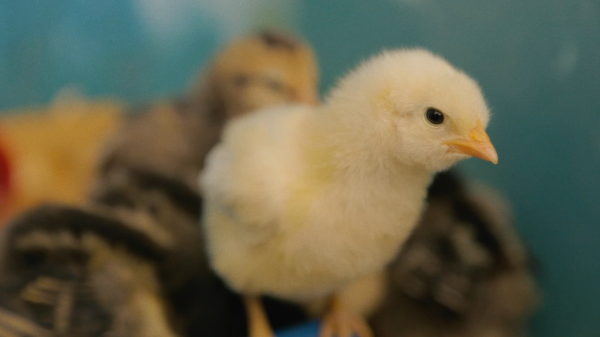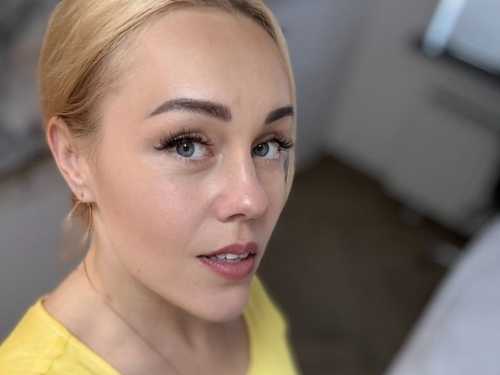
At a startup farm outside of Oakland, a young man reads on his phone in a dim bedroom. He’s not scrolling through social-media feeds or playing games; he’s trying to learn about caring for his livestock. A Siri-like voice-over says, “I found one article on how to take care of baby chicks.” On the floor, a large blue bucket sits under the warm glow of a heat lamp, with about a dozen fluffy chicks inside. “Failure to maintain a warm environment will quickly prove to be fatal,” the digital voice explains. The next morning, the chicks seem alive and well. A curious cat paces around the bucket, and is kept away from the chicks by a wire-mesh lid that is weighted in place with a piece of wood.
In the summer of 2019, the filmmaker Jonathan Pickett and his friends were participating in an intentional-living community facilitated by the Church of the Nazarene, volunteering in exchange for subsidized rent. When a ninety-five-acre farm in the area became available, Pickett and his group, with the help of church-affiliated staff, moved to the property. It came with several animals—chickens, goats, cows, and a boar—and none of the new residents had experience taking care of them. There was a steep learning curve at first, as the group relied on Google and local farmers for all of their agricultural know-how. Pickett was born in Kentucky, where his great-grandfather was a farmer, and his family moved to California when he was six; living on the farm turned out to feel more natural and exciting than he expected. “Upon getting there, it reignited this dormant Kentucky farmer that was in my blood,” Pickett told me. “And I just fell in love with the chickens.” Whenever he got off work as a film producer, he “would just crack a P.B.R. and kind of walk around and hang out with them.” And then one day he decided to pick up his D.S.L.R. and started filming his new feathery companions.
The New Yorker Documentary
View the latest or submit your own film.

Pickett wanted to make a documentary in which the chickens, not the humans taking care of them, were the main characters. “Maybe people will recognize the humanity in the chickens beyond what they might immediately see,” he said. “The life force that animates us humans is the very same life force that animates the chickens.” The people, whose names we never learn and whose faces we never see in focus, are the comical and peripheral sidekicks of the film, as they follow online advice about everything from reviving a weak, shivering baby chick to getting hens to lay eggs in nesting boxes. Tensions run high in the farm’s back coop, as the rescue roosters, originally bred for cockfighting, seem to have trouble giving up their old way of life. The farmers let the birds free-range for part of the day—“in order to diffuse pent-up aggression and boredom,” according to the voice-over—only to find themselves chasing a rooster who has invaded the hen pen on his stroll. Pickett did his own fair share of Googling, too. “I duked it out with a couple of roosters,” he told me. “I was reading online about how you show a rooster that you are the dominant alpha in the group, you know, like one does.” (Maintain eye contact with the rooster while walking slowly toward it, and be prepared to grab it and hold it upside down if it attacks.)
The free-range hens also present challenges—the newly minted farmers have trouble finding the eggs. They try some unorthodox methods, including strapping a GoPro to a hen to track its movements. The resulting footage, filmed from the back of a hen waltzing under a bench, then darting through bushes, and finally hiding under a porch, is dizzying yet delightfully immersive. Looking back, Pickett found it funny that he and his friends thought the GoPro would help them locate the hens’ “little secret nests.” It was a short-lived experiment, Pickett told me: “Once we could tell that she was really not stoked on it, we took it off.” The young farmers appear incredibly earnest in their efforts to explore the ancient tradition of caring for livestock, and they gradually learn what Pickett called “the tender care that goes into small-scale farming.”
Pickett filmed most of the footage in his first month of living on the farm. By the time he left, in 2021, the fresh eggs were in demand, and the farm had developed some loyal repeat customers. He sees the film as a sort of “time capsule” from the group’s days as novice farmers, and as “a love letter to that land, those people, and those chickens,” he told me. “It very much taught me to slow down and pay attention to the life that’s all around us and very easy to miss.” A couple of months ago, Pickett visited the farm—most of his friends no longer live there. The current residents are raising about a hundred and twenty chickens in the back coop now, and harvesting around seventy eggs per day. ♦
Sourse: newyorker.com






